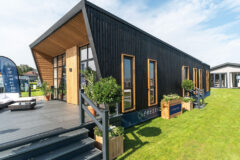New research suggests that stifled park home supply could lead to a price boost for park home owners. We learn more…
The latest analysis by residential park bungalow provider, Regency Living, suggests that there could be a surge in the average value of a residential park home in 2024, as the supply of residential park homes has fallen for the first time since the pandemic, despite demand remaining high for single-storey living.
Regency Living analysed data from the National Caravan Council (NCC), looking at the number of new residential park homes manufactured and how this pipeline of market supply has changed versus previous years.
Latest figures
The latest figures show that some 1,500 residential park homes were manufactured last year and while this total may sit 23 per cent higher than a decade ago, it marks a 17 per cent drop on the previous year and comes in some way below the annual average of 1,609 units manufactured a year since 2013.
In fact, it’s only the fourth year since 2013 where the sector has seen a reduction in the manufacture of new residential park homes and marks the lowest annual level of supply seen over the last decade – with the exception of 2020 when just 1,300 park homes were produced following the outbreak of the pandemic.
Like the wider bricks-and-mortar market, park home manufacturers have had to negotiate a far tougher market landscape as the result of higher interest rates, driving up costs.
However, while this may have stifled the supply of residential park homes reaching the market, demand for single-storey living remains robust.
In fact, previous research by Regency Living found that in the current market, 42 per cent of all bungalows currently listed for sale across England had already been snapped up by buyers, while additional industry data shows that around one in five residential park homes had already been sold in the first quarter of 2024, climbing to 35 per cent in some counties.
‘Vastly different’
A Regency Living spokesperson commented: ‘The delivery of park home housing stock is vastly different to that of the bricks-and-mortar sector. However, that doesn’t mean the residential park home market has remained immune to the wider economic challenges facing the property market over the last year.
‘With interest rates having climbed considerably and inflation remaining high, along with material and manufacturing costs, the number of new residential park homes reaching the market has inevitably reduced.
‘While this may be a temporary trend, it does present a potential opportunity for park home owners, who may now see the value of their property climb over the year ahead. We’ve seen demand for residential single-storey living and park homes, in particular, remain consistently high amongst downsizers.
‘With demand not letting up against a backdrop of insufficient supply, the value of residential park homes is likely to increase.’



